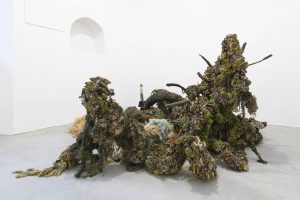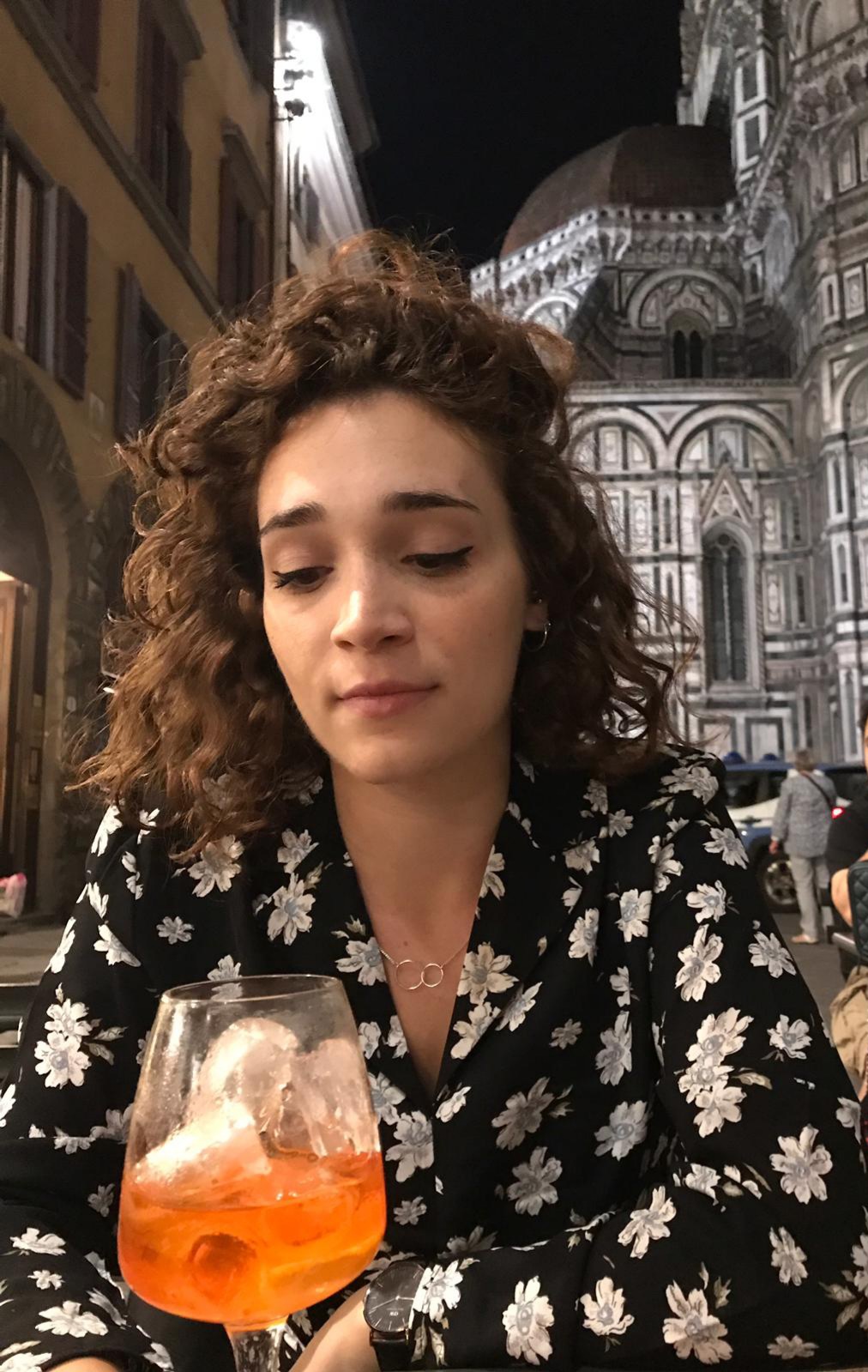The fifth edition of straperetana has been presented from 17 July to 22 August, with an exhibition in the medieval borgo of Pereto (AQ), curated by Saverio Verini in collaboration with Matteo Fato. The show deals on concepts like the strange and the creepy, through the artworks of about 30 artists placed in different spaces. The New Abnormal is inspired to a new album of The Strokes, released during the lockdown in 2020, and mainly to The Weird and the Eerie (2016), an essay by Mark Fisher, who tried to define these two adjectives and their relationship with contemporary, analysing the cultural production of our times.
The two main venues of the exhibition are Palazzo Maccafani and Palazzo Iannucci, linked by some installations placed along the path and partly camouflaged into houses’ walls, that guide the visitor into the narrow alleys. In the first location we can move from a room to another, going up and down in the Palace with a sense of alienation.
The works by Francesca Banchelli, Carol Rama, Giulia Poppi, Gabriele Silli and Enzo Cucchi are set in the ground floor, and through their different subjects, materials and edges, create a strong relation with the two main themes of straperetana: metamorphosis and perturbing. This sensation is successfully confirmed downstairs by Luca Francesconi with Cafoni (2014 – 2016), little humanoid metal sculptures whose head is made of vegetables, and also in the dark tank by Oscar Giaconia with a site specific installation, BHULK (2020). The artist presents a big shelf, full of strange and misterious objects, as an alchemy laboratory or a holy structure, that rejects and attracts our glance at the same time.
Going out and overcoming the square we step down and meet unexpected objects, like some festoons by Letizia Scarpello (Idiótes, 2020); small photos by Silvia Mantellini Faieta (Protezione visibile, 2019) and the gold plaque by Mattia Pajè (Ragnetto, 2020). These three works are about a contrast game: celebrating an event without the exciting of a party; the greatness of a landscape reduced to its miniature set amongst the stones; the banality of a ceremony for a spider freedom that became formal.
After a few steps we can see in the corner Malutta ripara e sostituisce (2017), by two artists from Fondazione Malutta collective (Thomas Braida and Valerio Nicolai). They created a paradox fixing badly a flowerbed and a gutter, a parody of restoration and requalification that could be both necessary in the borgo.
The short circuit triggered by these combinations of meanings goes on until we arrive at Palazzo Iannucci, when we pay attention by a strange assembling by Giovanni Termini. Oasi (2021) is an atypical fountain, whose water falls from a high lamp to a container, where the artist put a closed sun umbrella, like an ironic but nostalgic sculpture, that impose itself in the square.
The inside of the Palace host a group of works reflecting about the relationship between natural and artificial, in a climax that starts in the ground floor, where the link with reality and nature is stronger, while ending at the second floor where we find only unknown and misterious points.
The installation Voci discrete di vecchie canzoni (2021) by Daniele Di Girolamo proposes an unstable dimension, through a mixture made between recorded pollination sounds and objects infected by plants or flowers, that symbolise the context evoked by sounds.
In the following rooms Paride Petrei (Tripode anfibio monopinnato, 2020) and Edoardo Manzoni (Richiamo Vivo, 2020; Senza Titolo, Figure, 2021) present the anxiety of a nature that we can’t recognise because camouflaged as an object, or disappeared, in a goshtly atmosphere of absence.
Going upstairs the artworks are focused on body and his representation, showing a transfigurated and distorted reality, recalling dark memories. In the kitchen there are two pieces by Giuditta Branconi, ispired to Ovid’s Metamorphosis, are in dialogue with Biotope #0 (2012) by Claudia Losi, in a disturbing swing of the gaze between the two paintings and the sculpture on the table.
Arriving on the last floor we meet Pinocchio (2021) by Andrea Salvino, main symbol of metamorphosis and duplicity, so he closes the path in a sign of strange and hybrid.
From the beginning to the end of straperetana exhibition we cross up and down many inside and outside spaces, understanding the sense of unsolved and tension, in which we can actually recognise our contemporary and reality that we are involved in.
Cecilia Buccioni
Info:
 Palazzo Maccafani, Stanza delle Muse (da sinistra): Carol Rama, Feticci, 2002. Graphite, watercolor and enamel on canvas paper (project), 24,5 x 34,5 cm. Courtesy: Renato Alpegiani Collection; Giulia Poppi, sffsssshh, 2021. Virgin PETG, variable size. Courtesy: The artist. Project in collaboration with Ultravioletto and pPastopiave
Palazzo Maccafani, Stanza delle Muse (da sinistra): Carol Rama, Feticci, 2002. Graphite, watercolor and enamel on canvas paper (project), 24,5 x 34,5 cm. Courtesy: Renato Alpegiani Collection; Giulia Poppi, sffsssshh, 2021. Virgin PETG, variable size. Courtesy: The artist. Project in collaboration with Ultravioletto and pPastopiave
 Palazzo Maccafani, stanza della Nicchia: Gabriele Silli, Untitled, 2021. Mixed media (iron, wood, ropes and ropes – about 45 m -, glues, resins, various pigments, paper, leather, linen, hemp, marine mucilage, algae and other organic materials), variable size. Courtesy: the artist
Palazzo Maccafani, stanza della Nicchia: Gabriele Silli, Untitled, 2021. Mixed media (iron, wood, ropes and ropes – about 45 m -, glues, resins, various pigments, paper, leather, linen, hemp, marine mucilage, algae and other organic materials), variable size. Courtesy: the artist
 Palazzo Maccafani, Cisterna: Oscar Giaconia, BHULK (Caput Casei), 2020; Oil on lubricated paper and casein in PLA 3D print and silicone case, 40 x 30 cm (50 x 40 cm framed) installed in a wooden structure, polyurethane fiber and latex, 3D inserts in PLA, lubricated polyethylene and props, 216 x 250 x 50 cm. Courtesy: OG STUDIO and Monitor, Rome/Lisbon/Pereto
Palazzo Maccafani, Cisterna: Oscar Giaconia, BHULK (Caput Casei), 2020; Oil on lubricated paper and casein in PLA 3D print and silicone case, 40 x 30 cm (50 x 40 cm framed) installed in a wooden structure, polyurethane fiber and latex, 3D inserts in PLA, lubricated polyethylene and props, 216 x 250 x 50 cm. Courtesy: OG STUDIO and Monitor, Rome/Lisbon/Pereto
 Palazzo Iannucci, Claudia Losi, Biotope # 0, 2012. Wool felt and technical fabrics, padding, sand, approx. 40 x 40 x 130 cm. Courtesy: the artist and Galleria Monica de Cardenas; Giuditta Branconi, Dangerous and flattering languor (what are you doing? Do you see or dominate?), 2021. Oil on linen, 212 x 212 cm. Courtesy: the artist
Palazzo Iannucci, Claudia Losi, Biotope # 0, 2012. Wool felt and technical fabrics, padding, sand, approx. 40 x 40 x 130 cm. Courtesy: the artist and Galleria Monica de Cardenas; Giuditta Branconi, Dangerous and flattering languor (what are you doing? Do you see or dominate?), 2021. Oil on linen, 212 x 212 cm. Courtesy: the artist
For all the images: Photo Credit Giorgio Benni

After graduating in Cultural Heritage, she moved to Milan and finished her studies at the IULM University, where she specializes in contemporary art and communication. She currently lives in Pescara and works in a cultural association, collaborates with an art gallery and is a contributor for Juliet Art Magazine and Rivista Segno. She is in constant exploration of the artistic contemporaneity and its multiple readings.






NO COMMENT